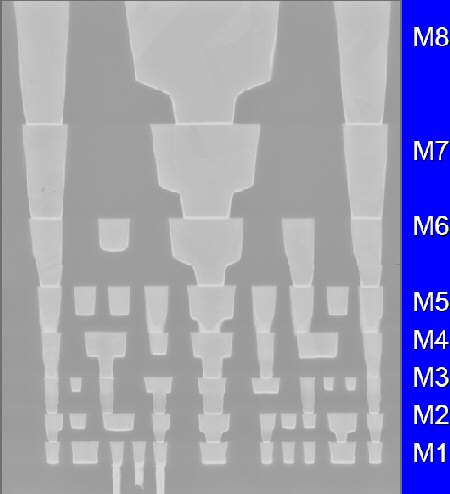The Quest for More Processing Power, Part One: "Is the single core CPU doomed?"
by Johan De Gelas on February 8, 2005 4:00 PM EST- Posted in
- CPUs
CHAPTER 3: Containing the epidemic problems
Reducing leakage
Leakage is such a huge problem that it could, in theory, make any advance in process technology useless. Without countermeasures, a 45 nm Pentium 4 would consume 100 to 150 Watts on leakage alone, and up to burn 250 Watts in total. The small die would go up in smoke before the ROM program would have finished the POST sequence.
However, smart researchers have found ways to reduce leakage significantly. SOI – Silicon on Insulator - improves the insulation of the gate and thus reduces leakage currents. SOI has made process technology even more complex, making it harder for AMD to get high binsplits on the Opteron and Athlon 64. However, it is clear that the Athlon 64 has a lot less trouble with leakage power than the Prescott, despite the fact that the Athlon 64 has only 20% less transistors than the Intel Prescott (106 versus 125 million).
The most spectacular reduction of leakage will probably come from Intel's "high-k" materials, which will replace the current silicon dioxide gate dielectric. Thanks to this advancement and other small improvements, Intel expects to reduce gate leakage by over one hundredfold! This new technology will be used when Intel moves to 45nm technology.
Another promising technique is Gate Bias technology. By using special sleep transistors, leakage can be reduced by up to 90% while the dynamic power is also reduced with 50% and more.
Body Bias techniques make it possible to control the voltage of a transistor. The objective is to make transistors slow (low leakage) when they are not used, and fast when they are. Stacked transistors and many other technologies also allow for reduction in leakage.[4]
One could probably write a book on this, but the message should be clear: the leakage problem is not going to stop progress. SOI already reduces the problem significantly and high K materials will make sure that the whole leakage problem will remain to be a nuisance, but not a major concern until the industry moves to even smaller structures than 45 nm.
At the same time, strained silicon will reduce the amount of dynamic power needed. With strained silicon, electrons experience less resistance. As a result, CPUs can get up to 35 percent faster without consuming more. This is what should allow the Athlon 64 stepping "E0" to reach higher clock speeds without consuming more.
Reducing Wire Delay
Although wire delay has not been so much in spotlight as leakage power, it is an important hurdle that designers have to take when they target high clock speeds. The resistance of wires has been reduced by both AMD and Intel using copper instead of aluminium. Capacitance has been lowered by using lower-K materials separating wires.

Fig 5. 8 Metal layers to reduce wire delay in Intel's 65 nm CPUs
Adding more metal layers is another strategy. More metal layers enable the wires connecting different parts of the CPU to be packed more densely. More densely means shorter wires. And shorter wires result in lower resistance, which, in turn, reduce the total RC Delay.

Fig 6. Repeaters on the Itanium Die
Of course, there are limits on what adding more metal layers, using SOI and lower-K materials can do to reduce RC delay. If some of the global wires are still too long, they are broken up into smaller parts, which are connected by repeaters. Repeaters can be used as much as you like, but they consume power of course.
Now that we have wire delay and leakage more or less out of control, let us try to find out what went exactly wrong with the Pentium 4 "Prescott". The answer is not as obvious as it seems.










65 Comments
View All Comments
Momental - Wednesday, February 9, 2005 - link
#41, I understood what he meant when he stated that AMD could only be so lucky to have something which was a technological failure, ie: Prescott, sell as well as it has. Even the article clearly summarizes that Prescott in and of itself isn't a piece of junk per se, only that is has no more room for evolution as Intel originally had hoped.#36 wasn't saying that it was a flop sales-wise, quite the contrary. The thing has sold like hotcakes!
I, like many others here, literally got dizzy as I struggled to keep up with all of the technical terminology and mathmetical formulas. My brain is, as of this moment, threatening to strike if I don't get it a better health and retirement plan along with a shorter work week. ;)
Ivo - Wednesday, February 9, 2005 - link
1. About the multiprocessing: Of coarse, there are many (important!) applications, which are more than satisfied with the existing mono-CPU performance. Some other will benefit from dual CPUs. Matrix 2CPU+2GPU combinations could be essential e.g. for stereo-visualization. Probably, desktop machines with enhanced voice/image analytical capabilities could require even more sophisticated CPU Matrices. I suppose, the mono- and multi-CPU solutions will coexist in the near future.2. About the leakage problem: New materials like SOI are part of the solution. Another part are the new techniques. Let us take a lesson from the nature: our blood-transportation system consists of tiny capillaries and much thicker arteries. Maybe it could make sense to combine 65 nm transistors e.g. in the cash memory and 90 nm transistors in the ALU?
Noli - Wednesday, February 9, 2005 - link
"Netburst architecture is very innovative and even genial"genius-like?
If by genial you mean 'having a pleasant or friendly disposition', it sounds weird. It can mean 'conducive to growth' in this context but that's not so intuitive because a) it wasn't and b) at best it was only theoretically genial.
Presumably it's not genial as in 'of or relating to the chin' :)
Agree monolithic was confusing but it was the intel dude who said it - I thought it meant 'large single unit' rather than 'old (as in technology)' as in: increasing processing power by increasing the size and complexity of a single core is now not as efficient as strapping two cores together - a duallithic unit :)
Sorry to be a pedantic twat.
Xentropy - Wednesday, February 9, 2005 - link
Some of the verbage in that final chapter makes me wonder how much better Prescott might have done if Intel had just left out everything 64-bit and developed an entirely different processor for 64-bit. Especially since we won't have a mainstream OS that'll even utilize those instructions for another few months, and it's already been about a year since release, they could have easily gotten away with putting 64-bit off for the next project. It's pretty obvious by now even the 32-bit Prescotts have those 64-bit transistors sitting around. Even if not active, they aren't exactly contributing to the power efficiency of the processor.I think one big reason Intel thinks dual core will be the savior of even the Prescott line is supposedly dual cores running at 3Ghz only require equivalent power draw to a single core at 3.6Ghz and should be just as fast in some situations (multitasking, at least). Dual core at 85% clockspeed will be slower for gaming, though, so dual core Prescott still won't close the gap with AMD for gaming enthusiasts (98% of this site's readership), and may even represent an even further drop in performance per watt. Here's hoping for Pentium-M on the desktop. :>
piroroadkill - Wednesday, February 9, 2005 - link
#36 -- You really didn't read the article and get the point of it. It wasn't a failure from a sales point of view, and this article was not written from a sales point of view, but a technical point of view, and how the Prescott helped in furthering CPU technology.Thus, a failure.
ViRGE - Wednesday, February 9, 2005 - link
Although I think I sank more than I swam, that was a very good and informative article Johan. I just have one request for a future article since I'm guessing the next one is on multi-core tech: will someone at AT run the full AT benchmark suite against a SMP Xeon machine so that we can get a good idea ahead of time what dual-core performance will be like against single core? My understanding is that the Smithfields aren't going to be doing much else new besides putting 2 cores on one die(i.e. no cache sharing or other new tech), so SMP benchmarks should be fairly close to dual-core benchmarks.Griswold - Wednesday, February 9, 2005 - link
Point and case as to why the marketing department is the most important (and powerful) part of any highly successful company. It's not the R&D labs who tell you what works and what comes next, it's the PR team.quidpro - Wednesday, February 9, 2005 - link
Someone needs to make a new Tron movie so I can understand this better.tore - Wednesday, February 9, 2005 - link
Great article, on page 3 you talk about BJT transistor with a base, collector and emitter, since all modern cpu's use mosfets should you talk about a mosfet with a gate, source and drain?Questar - Wednesday, February 9, 2005 - link
"The Pentium 4 "Prescott" is, despite its innovative architecture, a failure."AMD wishes they had a "failure" that sold like Prescott.